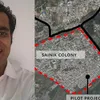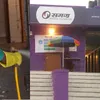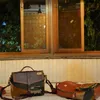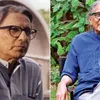From trends to transformation: how the Bengaluru ByDesign Festival 2019 showcases the power of art and design
In Part II of our photo essay on BbDF 2019, we feature more creative works along with insights on the practice and purpose of art and design.
Launched in 2014, PhotoSparks is a weekly feature from YourStory, with photographs that celebrate the spirit of creativity and innovation. In the earlier 405 posts, we featured an art festival, cartoon gallery. world music festival, telecom expo, millets fair, climate change expo, wildlife conference, startup festival, Diwali rangoli, and jazz festival.

The Bengaluru ByDesign Festival (BbDF) wrapped up its second annual edition this month with ten days of workshops, panels and exhibitions in venues across the city. See Part I of our article here, as well as Part I, Part II, and Part III of our coverage of the 2018 edition. Our d.Zen section offers more resources and insights from the world of design.
The Bangalore International Centre (BIC) featured a range of creative works by Liz West, Jane Withers, Anupama Kundoo, Vitek Skop, Jakub Szczesny, John Gollings, Mariel Manuel, and designers from JD Institute and Pearl Academy.
John Gollings
Award-winning Australian photographer John Gollings has spent a lot of time in Bengaluru over the last 40 years. “While I have had previous exhibitions and given lectures bringing international work to India, the design and cultural community have given back to me in spades,” he explains, in a chat with YourStory.
“The history, vitality, and sophistication of Indian culture have informed my work and technical skills,” John adds. With a mutual exchange between Australia and India continuing, he sees invaluable cross-fertilisation ahead.
His photo exhibition at BbDF unites two streams of his career, the modern commercial architectural photography and the cultural documentation of lost civilisations. “By bringing them together, the viewer can study the ongoing similarities and power of major and timeless buildings,” John explains.
He also shares his views on the connections between photography, journalism, culture, and art. “The origins of photography are rooted in objectivity, the accuracy of memory, and the freezing of time. In a sense, it was anti-art. Meanwhile, the art world of other mediums was freed to explore a more expressive vision,” John explains.
“Now, the journalistic documentary photography has been taken over by live television, and photographers are free to explore a more subjective approach. The wheel has come full circle,” he observes. Interestingly, John had not seen a connection between the old and new subject matter in his works until the curator pointed out to him that he had been “shooting the history of the built world.”
“It is certainly a daily challenge to find an image that best describes the building and is an image that my client couldn’t make for themselves,” he says, describing his work. Photography has been an all-consuming passion for John since the age of eleven.
“I love the equipment, the chemistry, and the physics which generated the magic of seeing an image appear in the darkroom. The suspense of seeing if an image worked was part of the thrill,” he recalls. Digital, of course, has removed that aspect and killed the prospect of an accident of exposure making a stronger picture.
“For me, photography is a creative challenge and a lifestyle that gives wisdom through an amazing range of experiences. India has been responsible for much of that experience, both its architecture and humanity,” John says.
As trends in the world of photography, he points to mixed media, use of video, the use of social media to publish ephemeral images, and the growth of virtual reality with computer-generated photorealistic imagery.
John traces his professional growth as a photographer as well. “It has been a passage from becoming a master of the technology to the freedom to explore creativity,” he explains. Analogue photography was difficult and prone to failure, especially commercially. One never knew if an image had worked until the results were received from there lab.
“Now with digital, I know the focus and exposure are what I want, so I explore a series of frames that I combine in the computer to generate a narrative image, more akin to a painter,” he explains. Increasingly, he is following this direction with even more difficult subject matter and tools: for example, using infrared cameras and large drones with interchangeable lenses and complex post-production.
Success for John is totally dependent on finding a strong image that encapsulates the subject. “It is an internal battle, praise is valuable when the viewer responds. I never approach a job for money, that follows if you make good pictures,” he emphasises.
John’s current projects include documenting Australian aboriginal rock art, regarded as some of the oldest art in the world. “Some of it is 30,000 years old and creatively more advanced than anything found in Europe or Africa,” he says.
John offers tips to audiences and aspiring photographers as well. “You need to look at a lot of art and listen to explanations to finally get the confidence to make your own judgment. Much is just gimmicky, but occasionally you see work that explores the human condition and expands your mind. It’s an excitement that vibrates in your mind and body,” he evocatively describes.
John advises aspiring photographers and artists to work for themselves and keep pushing the vision. “Work through the ideas of others until you come out with your own art, there is a continuum of artistic development. Look and learn then practice forever. I learn more every day challenging myself,” he explains.
Jane Withers
One of the exhibits at BIC was Loo Cafe X Water Loop by Jane Withers and Anupama Kundoo. “With the Nature-Nurture theme, we wanted to look at design in the urban environment and how it might encourage biodiversity. It was fascinating to look at the design from a non-human perspective and work with an urban ecologist to understand the impact of materials on flora and fauna,” Jane explains.
Her collaborative project was presented as a concept for a free public toilet and ecological sanitation project at Hyderabad Design Week, and the project was invited to come on to Bengaluru as well. Jane sees design festivals as playing a significant role in terms of providing platforms, particularly for the new designs.
“But there are now so many design festivals that we need to be careful that design isn’t just made for festivals, that it has relevance and impact beyond the festival circuit,” Jane cautions. As her favourite festivals, she cites Milan Design Week, London Design Festival, and Dutch Design Week.
As trends in design, Jane points to circularity and looking at the lifecycle of resources and materials. “It is critical that we design our waste,” she urges. She says it is vital to make art and design accessible to the young and a part of their culture from an early age. She cites Steve McQueen’s project Year 3 at Tate Britain as an amazing catalyst for this.
She sees many different meanings for art and design, but both are powerful at helping understand big issues and envisage alternative realities. “Design is a great synthesiser, bringing together different disciplines and inspiring change,” Jane enthuses.
She sees the lines between art and design as constantly shifting and blurring. “But I’m not really that interested in design that wants to become art. There are so many critical issues for design to tackle in the face of the climate crisis, which make for an important focus,” Jane says.
“Dive in deep and allow time to view art, learn as much about the context as you can, but also allow space for your own interpretation,” she advises designers and artists. Jane has also collaborated in projects like The Ancient Design Futures water station. It is proposed as an alternative to the office water cooler, encouraging visitors to pause and sip cool water served in traditional style from a terracotta vessel.
Jakub Szczesny
Polish architect Jakub Szczesny presented an exhibit called the Taburete Tower, a modular sculpture. It was dismantled on the last day of the festival and distributed as a set of stools among 70 people.
“This way, the participants bring home the festival and its prime message of democratic design,” Jakub evocatively describes. Every year, tons of precious installations end up in the trash after festivals, because they seem to matter only during the festival. He asks, “What if we'd think about temporary installations as transformable objects that after festivals become useful elements in the lives of people who participated in or visited the festival?”
The installation was well received in Bengaluru. Jakub remarks: “I was surprised, everybody wanted a stool after the festival, maybe because it's for free?!”
He sees artistic architecture as linked to deep focus and even as a form of meditation. “Art enables expressions otherwise difficult to perform in architecture, like storytelling, role-playing, and even public participation,” he explains.
“Architecture and design revolve around functionality, while art's functions have very different dimensions,” he observes. “Art also gives me a possibility and a privilege in itself to "visit" lives of other people,” Jakub says.
He loves traveling and connecting with people around the world, especially at festivals. “India, for instance, showed all kind of treasures I would not expect from a touristic voyage,” Jakub explains. He met a range of intellectuals and also taught students from Anant University in Ahmedabad.
The first version of his work Taburete Towers was spotted at Concentrico Festival in Logrońo (Spain) by the BbDF curator. In this regard, Jakub sees festivals as playing an important role in bringing together a unique mixes of artists, architects, designers, developers, and intellectuals.
He urges designers and developers to rethink their positions after the publication of the UN's report on the climate crisis. “Nothing matters as much after that, especially for people who have children, which includes myself. We start thinking about not only materials but also processes and sourcing and the next lives of our creations,” Jakub explains.
He teaches subjects like the design of public spaces at the School of Form in Poznań, and has given talks in Warsaw, Sao Paulo and Ahmedabad as well. “I like teaching a lot, but teaching has to be combined with rich practice,” he explains.
Jakub sees success for himself as “beyond prizes, power and respect.” Instead, success lies in the possibility of bringing to life ideas from scratch. Appreciation of art and design can be improved by encouraging people to do more physical things, and include it in education and media.
He has a range of ongoing projects. “I am working on a winter machine for Dubai, an educative art installation for a new science centre in Cracow called Cogiteon, and on my own house,” Jakub jokes.
He also offers tips for audiences and artists. “Imagine art is a live deer you suddenly see on your balcony. What do you do about it? What happens to you at the time?” he jokes. “Learn a lot, think a lot, live a lot, live long, and live for the others, not just for yourselves,” Jakub advises.
Vitek Skop
Czech designer Vitek Skop presented an exhibition around his product VividBooks, which uses AR to make print material “come alive.” This helps children better understand subjects like physics, and enjoy the learning process.
“Basically, students in the class will receive printed A5 worksheets from the teacher. Use of the smart device helps explain the physical action in motion, interactively, playfully, and sometimes in a funny way. AR makes the whole process magical and truly engaging,” Vitek enthuses.
VividBooks premiered at the London Design Festival as part of the UMPRUM University exposition, where it was noticed by BbDF curator Suprita Moorthy. “I think each designer defines success differently. For me, personally, the greatest success will be if I can teach some children a little better physics thanks to the Vividbooks project,” Vitek explains.
Design should be for the people, and not for one’s ego, he feels. “There is no target. There is only a journey and one has to really enjoy it. Love your work and have some fun while doing it,” he says.
Vitek’s earlier work was in areas like corporate branding, but now his focus is on interactive textbooks for children. “I do not want Vividbooks to be just for the elites, thereby widening the differences between students,” he insists.
He says he has received enthusiastic audience reactions. “People are usually really excited. They often want to help us get the project to schools. In India, people are incredibly helpful and open. They are taking business cards and trying to spread the word to anyone who has anything to do with a school system,” Vitek proudly says.
“In London, a little boy came to the exhibition and said that he wants to start a petition at his school to use the VividBooks textbooks. In Prague, at the designblok festival, the famous Italian designer Rossana Orlandi came to me and said that she was observing a little boy playing with VividBooks,” Vitek recalls.
Apparently, the boy was dyslexic, and thanks to visual animations he finally understood what they were discussing in class. “Rosanna was incredibly astonished when I told her that I am myself a dyslexic and dysgraphic,” Vitek recalls.
“I believe that education is one of the greatest tasks for us designers. Especially in a world where we have to repeat over and over again that the earth is really not flat. Education is an incredibly complex and malleable organism,” Vitek cautions.
He offers tips to aspiring designers as well. “Good design has many forms and positions. To me, the most precious design is not a priori beautiful. I don't think beauty is something that designers should be desperately looking for. That was a task for previous generations of designers. They invented beautiful products, beautiful typography, and amazing compositions,” he explains.
“Good designers today should be observing carefully the world around us and wonder what they can do to help. Find a problem and answer it with a solution. Go deep and not slip on the surface of aesthetics,” Vitek advises.
Designers must respond quickly to the social changes which are thrown in their way. “We designers can behave responsibly and help with our skills to handle this transformation,” he says, pointing to children’s smartphone addiction as a problem that can be tackled.
“One possible way is to get smartphones out of the schools. The other way is to show the kids that is possible to use smart devices in different ways than just unlimited scrolling on social sites. Push them from passive consumption of information to actively working with the device, creating content and projects,” Vitek urges.
He also advises aspiring designers to be curious, be critical and constantly ask themselves why they do what they do. “The question of “why” is one of the most important things in the designer's practice,” Vitek emphasises. He conducted workshops at the JD Institute of Fashion and Technology and Ahmedabad at Anant University, where he helped participants explore the nature of meaning.
“I have this feeling that a lot of developers are using AR just because it is trendy. The results are often funny shallow entertaining apps,” he cautions. AR is more than “funny stuff for occasions.”
“It is up to us designers to show to the people where might be a good place for the technology and which problem in our lives they might solve,” Vitek signs off.
Now, what have you done today to stop in your busy schedule, and find ways to harness the transformative power of art and design?























Got a creative photograph to share? Email us at [email protected]!
See also the YourStory pocketbook ‘Proverbs and Quotes for Entrepreneurs: A World of Inspiration for Startups,’ accessible as apps for Apple and Android devices.













